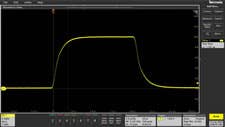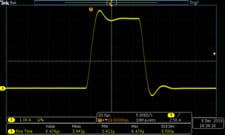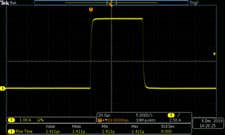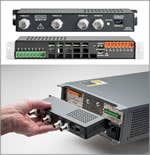Keithley Instruments 2601B-PULSE
Single-Channel System SourceMeter 10 μs Pulser/SMU Instrument
Keithley Instruments 2601B-PULSE
Single-Channel System SourceMeter 10 μs Pulser/SMU Instrument
The Keithley 26018-PULSE System SourceMeter 10 μs Pulser/SMU Instrument with PulseMeter technology is a high current/high speed pulser with measure plus the full functionality of a traditional SMU. This new pulser offers leading 10 A current pulse output at 10 V with a pulse width minimum of 10 μs, perfect for testing vertical cavity surface emitting lasers (VCSEL) used in LIDAR and facial recognition.
- 10 A@ 10 V, 10 microsecond pulse output
- No tuning required
- 10 A@ 10 V, 10 microsecond pulse output
- No tuning required; works with inductive loads up to3 μH
- Dual 1 Megasampe/second digitizers for high speed IN pulse measurements (pulser function only)
- DC capability up to ±40 V@ ±i.O A, 40 Watt
- TSP technology embeds compete test programs inside the instrument for best-in-class system-level throughput
- TSP-Link expansion technology for multi-channel parallel test without mainframe
- US8 2. 0, LXI Core, GPIB, RS-232, and digital 1/0 interfaces
- Supported in Keithley KickStart non-programming software tool
Applications
- Optoelectronic devices such as vertical cavity surface emitting lasers (VCSELs), laser diodes, light emitting diodes (LEDs), high brightness LEDs (HBLEDs), displays
- Discrete and passive components including sensors, disk drive heads, metal oxide varistors (MOVs), diodes, Zener diodes, sensors, capacitors, thermistors
- Simple ICs - Optos, drivers, switches, sensors, converters, regulators
- Integrated devices - small scale integrated (SSI) and large scale integrated (LSI):
- Analog ICs
- Radio frequency integrated circuits (RFICs)
- Application specific integrated circuits (ASICs)
- System on a chip (SOC) devices
- Wafer level reliability
- NBTI, TDDB, HCI, electromigration
- Batteries
- Failure Analysis
The new 26018-PULSE System SourceMeter 10 μs Pulser/SMU Instrument with PulseMeter™ technology is a high current/high speed pulser with measure plus the full functionality of a traditional SMU. This new pulser offers leading 10 A current pulse output at 10 V with a pulse width minimum of 10 μs, perfect for testing vertical cavity surface emitting lasers (VCSEL) used in LIDAR and facial recognition, LEDs for lighting and displays, semiconductor device characterization, surge protection testing, and so much more. The pulser's built-in dual 1 Megasample/second (MS/s), 18-bit digitizers make it possible to acquire both pulse current and voltage waveforms simultaneously without the need to use a separate instrument. The 2601 B-PULSE is a powerful solution that significantly boosts productivity in applications ranging from benchtop characterization through highly automated pulsed 1-V production test. For automated system appications, the 26018-PULSE's Test Script Processor (TSP®) runs complete test programs from inside the instrument for throughput. In larger, multi-channel applications, the Keithley TSP-Link® technology works together with TSP technology to enable high-speed, pulser/SMU-per-pin parallel testing. Because the 26018-PULSE offers full isolation that does not require a mainframe, it can be easily reconfigured and re-deployed as your test applications evolve.
Pulsed Testing for Device Characterization
Testing real device operation and minimizing the heating effects with on-wafer testing just got easier with the 26018-PULSE SMU. Thermal management is critical during the testing of many devices, especially those at the semiconductor wafer level, such as VCSELs, laser diodes, and LEDs. Pulsed 1-V testing minimizes the heating effects of the current in the device, especially if tested at the wafer level when devices have no temperature control circuitry. Testing with DC would either change their characteristics, or at worst, destroy them. Later on, in production, when they have been assembled into modules with temperature controls, the devices can be DC tested and the results compared to those from the pulsed test. Some devices will pass a DC test and fail a pulsed test due to device characteristic changes resulting from temperature shift. The 10 VI 10 A I 10 μs output of the 26018-PULSE ensures that you get a proper output pulse into your device and an accurate measurement when it is required.
No Tuning Required
When outputting current pulses, cabling and inductance can be a problem. Inductance can have a limiting effect and could even be damaging. Quite often, the inductance can be different from device to device, even when testing laser diodes on a wafer. The effect of inductance on a current source is that inductance resists changes in current. This can cause the current source to increase the output voltage. The result is overshoot and ringing as the pulse settles. This may not be acceptable in your test. Some solutions require tuning to compensate for these behaviors, which can be time consuming. The 2601 B-PU LSE's control loop system eliminates the need to tune for load changes up to 3 μH so that your pulse has no overshoot and ringing when outputting pulses from 10 μsup to 500 μsat a current up to 10 amps. This ensures a fast rise time, so your devices are sourced with a current pulse to properly characterize the device or circuit. The images on the next page show the performance of the 26018-PULSE with PulseMeter technology compared to a competitive modular SMU outputting a 5 A, 50 μs pulse on a device with an impedance of 3 μH.
Unmatched Throughput for Automated Test with TSP Technology
For test applications that demand the highest levels of automation and throughput, the 2601 B-PU LSE's TSP technology delivers industry-best performance. TSP technology goes far beyond traditional test command sequencers - it fully embeds, then executes, complete test programs from within the SMU instrument itself. This virtually eliminates the timeconsuming bus communications to and from the PC controller, and thus dramatically improves overall test times.
SMU-Per-Pin Parallel Testing with TSP-Link Technology
TSP- Link is a channel expansion bus that enables multiple 26018-PULSE SMUs to be inter-connected and function as a single, tightly-synchronized, multi-channel system. The 26018-PULSE's TSP-Link technology works together with its TSP technology to enable high-speed, SMU-perpin parallel testing. Unlike other high-speed solutions, such as large ATE systems, the 26018-PULSE achieves parallel test performance without the cost or burden of a mainframe. The TSP-Link based system also enables superior flexibility, allowing for quick and easy system re-configuration as test requirements change. TSP- Link uses a standard 100BASE-T ethernet cable, enabling you to connect not only multiple 26018-PULSE SMUs, but other TSP-based instruments in a master-subordinate configuration that operates as one integrated system. TSP-based instruments include the Keithley Graphical SourceMeter SMUs (2450, 2460, 2461, 2470), other Series 26008 System SourceMeter SMU instruments, the Keithley DMM7510 and DMM6500 Graphical Sampling Multimeters, and the Keithley DMM/Switch instruments, such as the Series 3700A Switch/Multimeter system and DAQ6510. The TSP-Link expansion bus supports up to 32 TSP- Link nodes, making it easy to scale a system to fit an application's particular requirements.
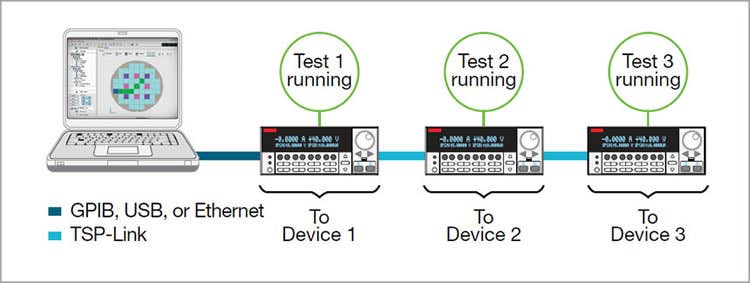
SMU-per-pin parallel testing using TSP and TSP-Link improves test throughput and lowers the cost of test
Instrument Control Start-up Software
KickStart instrument control/start-up software enables users to start making measurements in minutes without programming. In most cases, users merely need to make some quick measurements, graph the data, and store the data to disk for later analysis in software environments such as Microsoft Excel. KickStart offers:
- Instrument configuration control to perform 1-V characterization
- Native X-Y graphing, panning, and zooming
- Spreadsheet/tabular viewing of data
- Saving and exporting of data for further analysis
- Saving of test setups
- Screenshot capturing of graphs
- Annotating of tests
- Sending and receiving data using a command line dialog
- HTML help
- GPIB, USB 2.0, Ethernet compliance
Comprehensive Built-in Connectivity
Rear panel access to rear-input connectors, remote control interfaces (GPIB, USB 2.0, and LXl/ethemet), D-sub 25-pin digital 1/0 port (for internal/external trigger signals and handler control), and TSP-Link connectors make it simple to configure multiple instrument test solutions and eliminate the need to invest in additional adapter accessories.
The 26018-P-INT interlock I connector box interconnects both the SMU and Pulser functions and converts both of the Phoenix connectors on the rear panel to standard BNC connectors. The interlock/connector box also provides an optional safety interlock for use when testing LASER devices.
| Country of Origin | China |
|---|---|
| Brand | Keithley |
| Condition | NEW |
| Vendor Alias | KEITHLEY-2601B-PULSE |
- 1 - 2601B-PULSE Single-Channel System SourceMeter 10 μs Pulser/SMU Instrument <
- 1 - 2601B-P-INT 2601B-PULSE Rear Panel Interlock and Cable Connector Box
- 1 - 7709-30BA Digital 1/0 Connector
- 1 - 17469460X TSP-Link/Ethernet Cable (two per unit)
- 1 - CS-1616-3 Safety Interlock Mating Connector
- 1 - QuickStart Guide





